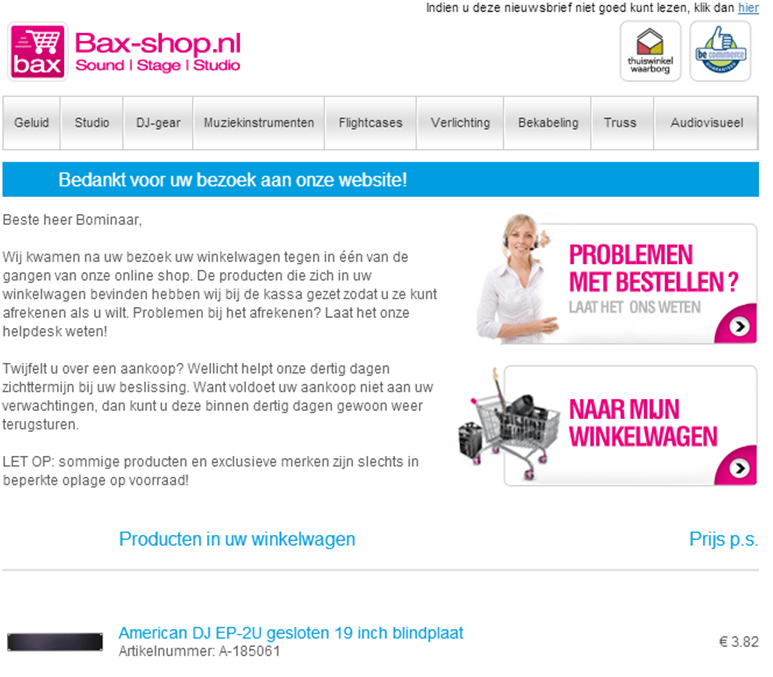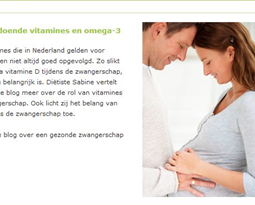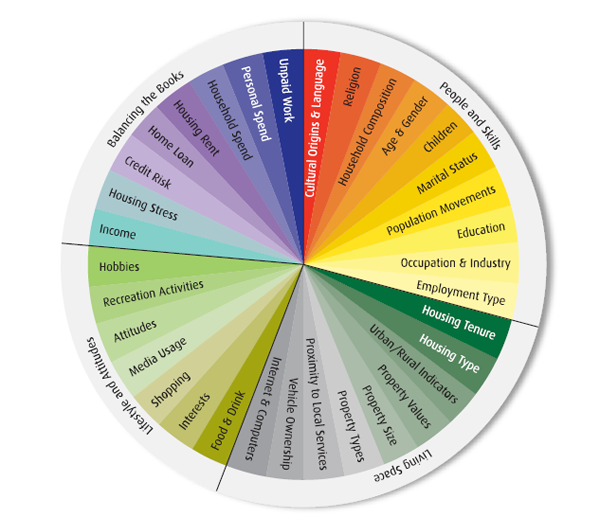Three crucial email marketing tips for 2013
Do you want to know how to generate the highest revenue using email marketing in 2013? Next year the global turnover for eCommerce will break through the 1 trillion euros barrier. Furthermore, the amount of internet users is expected to grow to more than 3.5 billion in 2013. But how do you make sure your web shop reaches your conversion goals in 2013? How can you optimally implement email marketing next year? These three tips will get you going:
1. Use triggers from your website
Your clients visit your web shop with several intentions. To subscribe for your email newsletter, to buy your products, to browse through your product range etcetera. Using different tools you can monitor this behaviour and use it as trigger for your email campaigns. A good and simple example is the welcome mail. A client subscribes for your newsletter and you send out a welcome mail with some further information. A contact moment you can use to persuade a new client into buying something from your web shop.
 For example, every new subscriber for Suitableshop.nl’s newsletter receives a discount code worth 10 euros that can be used when someone spends at least 99 euros in the web shop. This way Suitableshop stimulates its visitors to buy something when they initially had no intention of buying anything. Once this new subscriber performs his first purchase, he becomes an existing client. Next to its normal newsletters, Suitableshop can send these clients targeted emails with offers that fit the interests of the clients.
For example, every new subscriber for Suitableshop.nl’s newsletter receives a discount code worth 10 euros that can be used when someone spends at least 99 euros in the web shop. This way Suitableshop stimulates its visitors to buy something when they initially had no intention of buying anything. Once this new subscriber performs his first purchase, he becomes an existing client. Next to its normal newsletters, Suitableshop can send these clients targeted emails with offers that fit the interests of the clients.
Another trigger you can use based on website behaviour is the abandoned shopping cart. When a client fills his online shopping cart and doesn’t complete the purchase, you can send him an email with the products the client ‘forgot’ to buy. These type of campaigns are a great impulse for your conversion. But these campaigns are still not applied a lot in real-life. A strange fact when you consider the fact that people spend 55% more on average when buying after receiving an abandoned shop cart mail.(source: SeeWhy Research, 2011).
 Bax-shop sends abandoned shopping cart mails after a client ‘forgot’ to purchase his selected products. These mails generate an average open rate of 60% and a click-through rate of 34%. That’s both 40% and 20% higher than the open rate and CTR of their regular newsletters. Furthermore, Bax-shop uses these emails to remind their clients they can return ordered products within 30 days and they offer help if a client has a question about an order. Each one of them an extra tool to convince a client to finalize their purchase.
Bax-shop sends abandoned shopping cart mails after a client ‘forgot’ to purchase his selected products. These mails generate an average open rate of 60% and a click-through rate of 34%. That’s both 40% and 20% higher than the open rate and CTR of their regular newsletters. Furthermore, Bax-shop uses these emails to remind their clients they can return ordered products within 30 days and they offer help if a client has a question about an order. Each one of them an extra tool to convince a client to finalize their purchase.
2. Don’t forget that customer life cycle
These days, relevance is crucial when you want your client to open your emails. His inbox is a jungle of different offers, newsletters and service mails and it is up to you to make sure your email gets opened. Not an easy job when you know 4 out of 10 recipients mark an email as Spam simply because it doesn’t seem relevant enough.
Your client has different contact moments with your web shop that you can use to send relevant targeted messages using event driven email marketing. Examples of such contacts are birthday mails, reminder mails (for example, when someone’s warranty is about to expire), loyalty emails or emails after a client performed a purchase. But you can also send emails based on the lesser obvious moments. For example winback mails: emails you send to clients who haven’t purchased anything for a while (for example, 6 months) or who haven’t opened the last five email newsletters.
 FitForMe used segmentation to define different contact moments for their web shop for personalized vitamins and nutrition supplements. One of those moments is their ‘resupply email’. It’s possible that you have products in your web shop of which you know they will wear out or will need new supplements after a certain amount of time. Based on that knowledge you can set up targeted email campaigns. It’s actually a custom service for your client based on his previous purchases.
FitForMe used segmentation to define different contact moments for their web shop for personalized vitamins and nutrition supplements. One of those moments is their ‘resupply email’. It’s possible that you have products in your web shop of which you know they will wear out or will need new supplements after a certain amount of time. Based on that knowledge you can set up targeted email campaigns. It’s actually a custom service for your client based on his previous purchases.
3. Enriching profiles for more relevance
A well-stocked database offers countless possibilities. The more specific the information on your target group, the more targeted and relevant you can communicate with your target group. Not only by using a personal approach by adding a variable salutation, but also by communicating with the client based on his interests, needs or previous purchases.
Determine what extra data from your clients you would like to gather for your web shop. What information do you want to store and use? Use your marketing strategy to determine which groups you want to focus on and start gathering the information you need.
Think about gathering that information by registering and analyzing click, surf or buying behaviour. Or get extra information such as interests or date of birth by conducting surveys, setting up special action pages or sending targeted campaigns. But whatever you do, make sure you put that gathered information to good use. If you don’t, it is just a waste of time and profile enrichment if you just store the data and nothing more.
 To elaborate on the example of FitForMe: this web shop applies targeted communication based on gender. But also based on age, needs and purchase data. FitForMe adjusts the content, images and product offers within these emails using data such as age and needs. By using a nutrition test, FitForMe gathered data about a specific target group (pregnant women) enabling them to fully adjust the email campaign based on the needs of that specific target group.
To elaborate on the example of FitForMe: this web shop applies targeted communication based on gender. But also based on age, needs and purchase data. FitForMe adjusts the content, images and product offers within these emails using data such as age and needs. By using a nutrition test, FitForMe gathered data about a specific target group (pregnant women) enabling them to fully adjust the email campaign based on the needs of that specific target group.


















